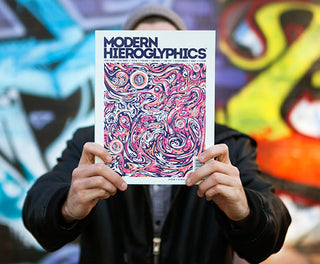Over the San Francisco Bay, on the East side, there are new voices in the contemporary art world. These voices are making their own history to build upon the already long-standing influence cities like Oakland and Berkeley have in arts and culture. A new arts publication that calls Berkeley home is contributing to the conversation here and abroad. Just like the hieroglyphics of various cultures in the past told their stories, Jack McKain’s Modern Hieroglyphics tells a story of a contemporary culture.
McKain has traveled the world the past year interviewing artists himself for his magazine and tells us about his journey into the world of publication. I learned of the guts and concept behind the magazine and gained some insight on what the next issue has in store for us. I was stoked to hear about Jack’s diplomatic and generous approach to choosing his featured cover artists. Make sure to pick up the next issue of a magazine with some fresh eyes on the scene and check out our interview below.
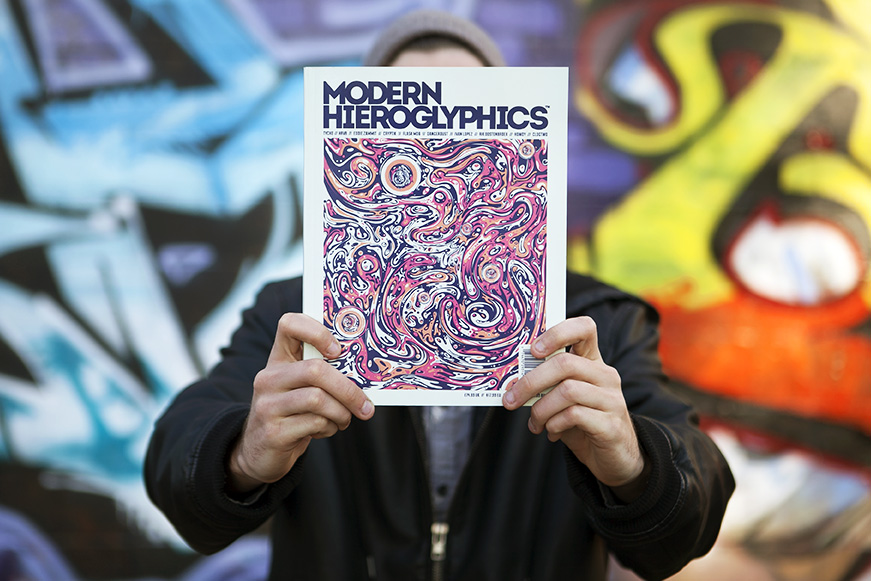
BROCK BRAKE: What is Modern Hieroglyphics?
MODERN HIEROGLYPHICS: I’ll take it way back and start from the beginning on this one... The term “Modern Hieroglyphics” has been alive since before I was even born. To my knowledge, a friend of mine by the name of Blame One in Oceanside, California, came up with the name back in the late ’80s. MH was originally the name of his graffiti crew. Chor Boogie was part of the crew, I believe Mike Giant was part of the crew, along with a handful of other writers in the San Diego area.
My journey with Modern Hieroglyphics began when I walked past Chor’s “Opium Horizons” mural in Clarion Alley in San Francisco in May 2013. I had been following his work and after seeing that mural, I decided to reach out. As I was looking for an e-mail address on his website, I came across a phone number and I got in touch with his agent, Dana. At the time, I had a blog with absolutely no content on it, and I told Dana I wanted to interview Chor. He seemed confused [laughs] and told me he would call me back. An hour later, Chor hits me up like, “Dude, come to my studio.”
I spent half the next day getting lost on buses trying to find my way up to Chor in San Rafael. I got off at the wrong stop like five times [laughs]. Finally, I get there, and I had never really done an interview before, but Chor was hella cool and we chopped it up for a while. I specifically remembered him mentioning a piece he painted in Baton Rouge called Modern Hieroglyphics, and the term stuck with me all day. I couldn’t get it out of my head. I was back in San Francisco that night, with a friend of mine, Trevor, who shoots for National Geographic. I was really stoked on how the interview went, and I wanted to build a platform to continue interviewing artists, and Trevor really inspired me to do something with the idea. He got his start as a photographer through a National Geographic grant, and he pushed me to apply for one myself.
I had this idea to shoot a documentary about street art and how it has evolved over time. I wanted to do what I’m doing now: travel and interview artists. I called Chor and asked him if I could use the name “Modern Hieroglyphics” as the title of the project, and not only was he cool with it, but he wanted to get involved. I spent the next six months applying for a grant from National Geographic to fund this documentary idea... I conducted interviews, I wrote out an entire proposal, and I made it to the finalist round. I had to submit a second application, and by this point I was positive that the grant was mine. But in December 2013, I got an e-mail... “The council voted not to recommend funding of your grant request.”
I was crushed. I had already begun to make plans around this documentary and there was no way I was going to make it happen without that NG backing. But during the entire time, I was working on the NG application, I had continued interviewing artists from around the world. I spoke to guys like L7M from Brazil, C215 from France, Nils Westergard from Virginia, and posted the interviews on my blog. And in the same week that I got the rejection e-mail, I had the idea to turn all of that blog content into a magazine. I talked to Chor and he was on board with it, he was down from day one, and the name translated perfectly. The idea started as a little zine, something with a couple pages that I could print out and give to my friends. But the more I worked on it, the more it grew.
“THE FAILURE FROM THE [NATIONAL GEOGRAPHIC] REJECTION WAS ALMOST LIKE THE CATALYST THAT DROVE ME TO DO WHAT I’M DOING NOW [WITH MODERN HIEROGLYPHICS].”
I was living in Richmond, Virginia, at the time, and at the end of December I dipped out and spent the next few months traveling. I went to LA, spent a couple months in Puerto Rico, went to Australia for a bit, then finally moved to San Francisco in late March. I had some money saved and I did freelance design work to pay for my rent and food, which gave me a lot of time to put thought into this project. I went into almost-reclusive work mode in April and May to bring the mag to life, working insane hours and pulling all-nighters working on the mag. And by mid-May, I had a 156-page InDesign document ready to print. I released the first mag in July, I’m releasing the second issue in a week, and I couldn’t be happier about how the National Geographic situation turned out last year. I don’t work for them, I don’t have to answer to anybody... I work for myself. The failure from the NG rejection was almost like the catalyst that drove me to do what I’m doing now. That’s more or less the shortened version of the long story of what the words “Modern Hieroglyphics” mean to me.
The “print is dead” idea has been a topic of discussion amongst journalists for many years now. When I was in journalism school, my professors told me to switch majors because print was dying out. You’ve encountered this similar stance since you started the magazine. What kept you going?
What kept me going was the fact that none of this was about money – and it’s still not about money. From the moment I decided to create a magazine, that in and of itself was my goal: to create a magazine. I really just wanted to hold it in my hands, you know? I constantly had people telling me that print was dead and that it wouldn’t sell. I even met the editor of Thrasher in a bookstore in the Mission and he straight up told me Modern Hieroglyphics was a shitty name and that nobody would buy it [laughs]. This was when the magazine was still just a concept in my head. I told him where I wanted to take it, and instead of encouraging me, he kinda just shit all over my dreams [laughs].
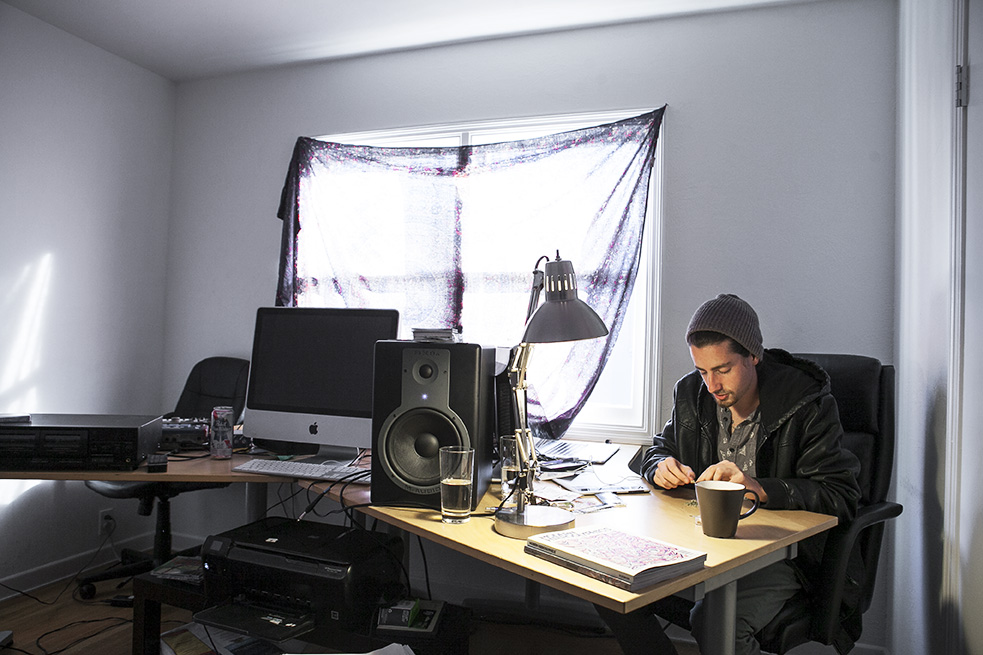
I’m at the point now where yes, I need to make money off of the magazine. The energy required to bring something like this to life is insane, the hours I work are borderline unhealthy [laughs], and I need to pay for all my travels and expenses. If it wasn’t selling, I wouldn’t be able to continue doing this. But the thing is, it is selling. We sold out of our first issue in a couple months and we’ve shipped copies out to 15 different countries. I guess what really keeps me going is that I love showcasing artists’ stories and work. I love connecting and sharing stories with so many interesting people around the world. I’m constantly surrounded by people who inspire me and I have the privilege of being able to share that inspiration with the world. And I love the lifestyle that it allows me to live. I get to set my own hours and make my own rules. I’ve been sleeping on floors and couches for months, hopping from city to city... it can be uncomfortable at times, but I’ve never been happier.
What can you tell me about the staff behind the magazine? Who’s on board and what do they do?
As I mentioned, Chor Boogie has been there since the beginning. He’s the co-creator of the magazine and he’s somewhat of a creative advisor to me. His work inspired the mag and without Chor (or his Clarion Alley mural), none of this would have happened. I recently brought an associate editor on the team, my homie Evan, who also DJs under the name Big Wave at all of our events. We share our Berkeley office and he’s been on the grind with me since the summer. He’ll be joining me for our upcoming release tour and he’s been a huge asset these past few months. My friends Ilya, Sean, Chase, and Moira have all helped out with editing along the way, and my younger sister Kristy has just started assisting in the accounting department.
What’s the day-to-day like in the Modern Hieroglyphics office?
There is no regular day-to-day. Every day is different... that’s what we’re all about. The physical MH office is in Berkeley, but half of the time, my office is in an airport or a coffee shop. I just got back to the bay after being gone for two months and I’m about to leave again next week. But when we are in the office, I’ll usually start the day with a cup of coffee, then we’ll roll one up and smoke once the sun goes down. It’s not unusual for us to be at the office until 4 or 5 in the morning. I can’t even remember the last time we stopped working before 3am.
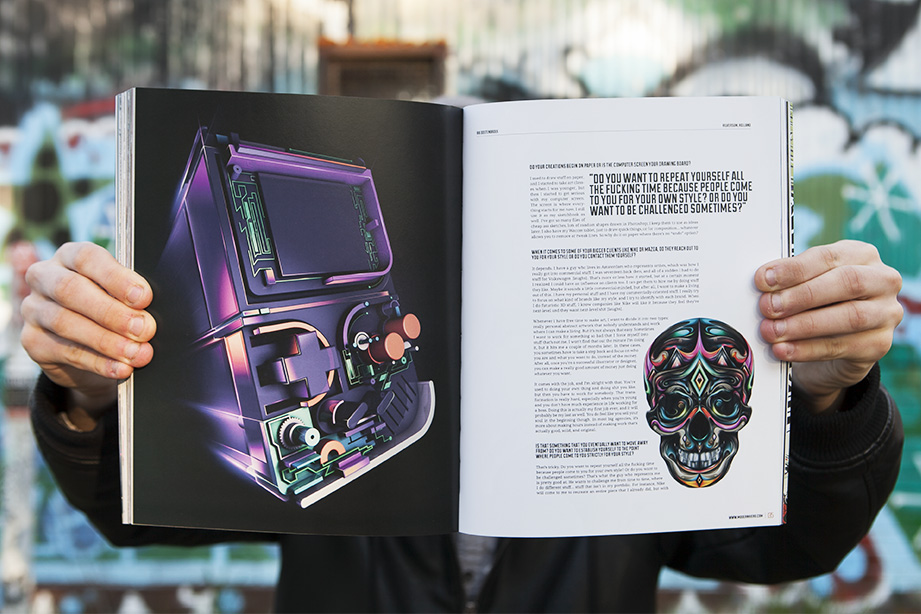
How is MH different than other contemporary art and lifestyle magazines?
My goal isn’t to just be different from other magazines; it’s more my goal to be true to myself and my own personal style... but I guess that has resulted in MH being different [laughs]. I really focus on long-format, in-depth interviews with artists. I want the reader to feel like they know the artist, and when I’m doing an interview, I want the artist to feel like they’ve discovered something new about themselves. The way I do my interviews, if the vibe is right, it ends up being much more of a conversation than a back-and-forth, question-and-answer dynamic. I always research and write questions, but half the time we’ll go off on tangents and I’ll end up making up new questions as I go. But yeah, at this point, I’m still creating the identity of the mag and I’m in no hurry. It will grow and differentiate itself organically.
“PEOPLE SAY THE INTERNET KILLED PRINT, BUT I THINK THEY CAN COEXIST AND EVEN THRIVE TOGETHER.”
The first issue of MH primarily focused on street art and graffiti culture. What can we expect from the second issue?
It’s funny, the second issue barely touches on street art or graffiti. I met with a street artist named HRVB out in Berlin, but he’s just as much of an illustrator as he is a street artist. The same goes for Clogtwo in Singapore. He’s insanely talented with a spray can, but I’m even more impressed by his daily sketches. The second issue is much more focused on illustration, design painting... but we also have interviews with a T-shirt collector and a feature on a photography event. My goal is really just to feature what I find visually interesting, whether that’s photography, digital design, or graffiti... whatever catches my eye, really.
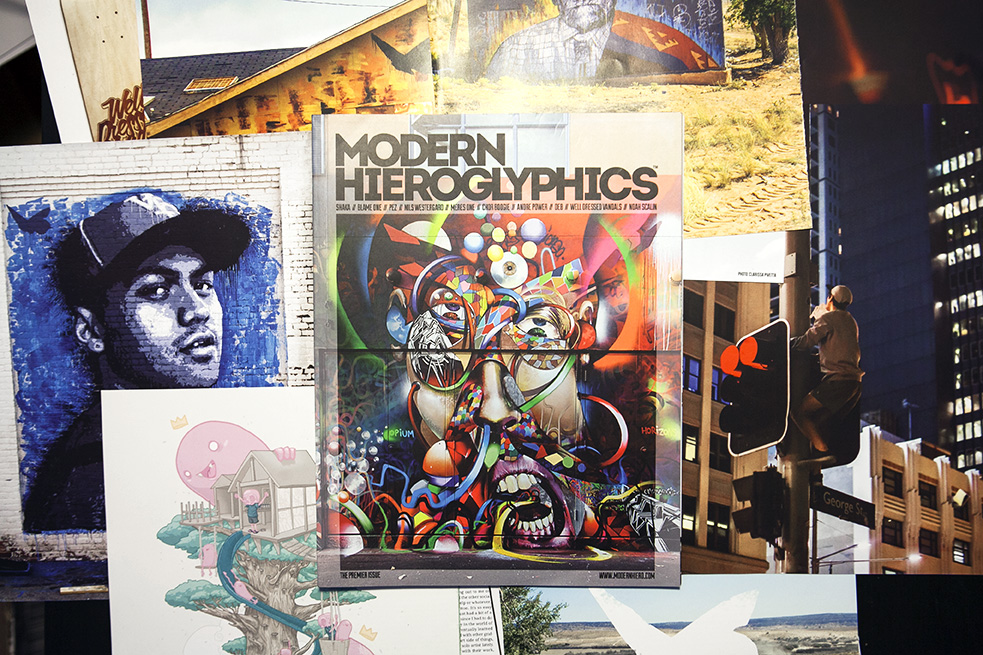
How do you go about deciding whom to interview and feature?
There are a lot of factors. It’s really important to me to feature a nice balance of well-known artists and artists who I think deserve more exposure. I’d like to eventually get to a point where we can put out magazines full of artists who nobody has ever heard of, and people will buy it anyway because they believe in the brand.
Magazines usually offer one or two covers for a limited edition feature. What made you decide to do eleven different covers?
I was actually struggling to choose an artist for the cover of this second issue for the longest time. I was discussing it with my friend Chase, and I remember him saying, “Sucks you can’t just do a cover for each artist...” My reaction to that was, “Why not?” [laughs]. I hated the idea of deciding who “deserved” to be on the cover of all the magazines. If you’re in the magazine, you deserve to be on a cover. So for this second issue, we’ll be releasing a limited edition cover design for each featured artist. There will be 100 copies of each cover, and once they sell out, we’ll never be re-printing them.
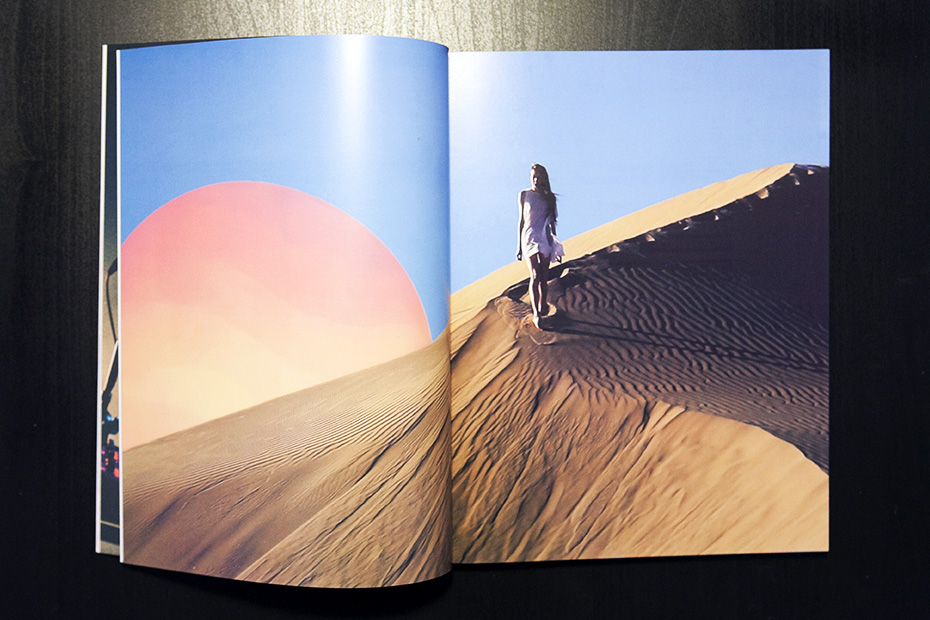
San Francisco based photography meet-up, Flask Mob, is in this upcoming issue. Looking at Instagram, the meet ups seem pretty wild. Tell us the story.
I was first introduced to Flask Mob through my homie Evan Thompson’s blog. He started the event in November 2013 as a way for photographers to meet up in the city. It’s a brilliant concept. When you attend a Flask Mob, you just bring a camera, doesn’t matter if it’s an iPhone, Polaroid, DSLR – whatever you got. You bring a flask or a bottle, bring some herb, or go sober if you want. It’s up to you. Everybody meets at a designated spot in the city and you just connect with the people and the urban environment. You got models out there posing for shots, dudes blowing fire, kids doing parkour and shit, and people with cameras documenting the whole thing. It’s like a massive roaming party. It’s raw and it’s rowdy and it’s really a beautiful thing to experience. The drinking and partying aspect is fun, but at the end of the day, it’s truly about photography and human connection. It started out as a group of fifty or sixty photographers, but has quickly grown into a massive movement. The last Flask Mob I went to, the local news estimated that over one thousand people were in attendance. We shut down the Stockton Tunnel in downtown San Francisco and it was surreal, like a scene out of a movie. There’s a 26-page feature on Flask Mob in the second issue of the magazine featuring 100% crowd-sourced imagery from people who had attended the event in the past. If you haven’t been, I highly recommend checking it out. The next Flask Mob is going down in LA on January 31st and our magazine release party on that night is also the official after party for the event. [Ticket link: http://bit.ly/lamodernhiero].
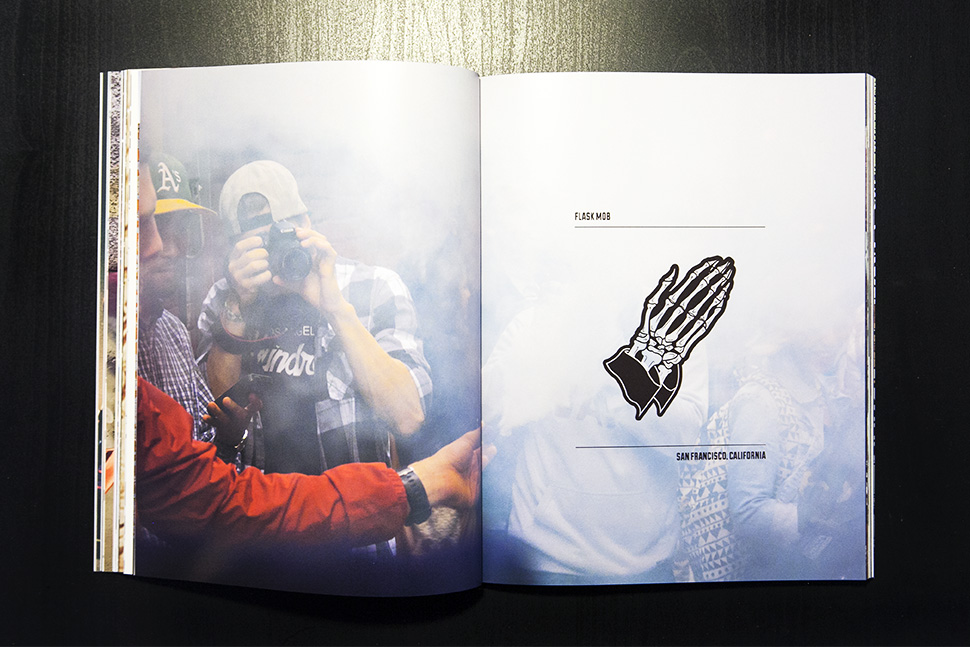
What drew you to interview audio/visual artists like Scott Hansen a.k.a Tycho? Does MH plan to showcase more music-related articles in print or online in the future?
I’ve been a fan of Tycho’s music for a long time, but it wasn’t until a year or two ago that I discovered he does all of his own artwork. Tour posters, album art, live visuals – it’s almost exclusively him doing all of that. And his artwork looks exactly like his music sounds, if that makes sense. I have a lot of respect for Scott and I’m absolutely blown away by everything he does. I was interested in the story behind his work and it only made sense for me to reach out so he can tell me his story personally. In the first issue, I spoke with Andre Power, the co-founder and art director of Soulection. He’s a musician, but our interview was about the role of his art direction in the identity of the label. We’ll continue to feature music-related content in print as long as there’s a visual element to it.
How has social media affected the growth of Modern Hieroglyphics?
I don’t know if any of this would be possible without social media – it allows me to discover and connect with anybody. A large portion of our sales come from our website, and most of the traffic on the site comes from Facebook and Instagram. We’ve gained a decent international following pretty quickly, and so far, we’ve actually sold more second issue pre-orders overseas than we have domestically [laughs].
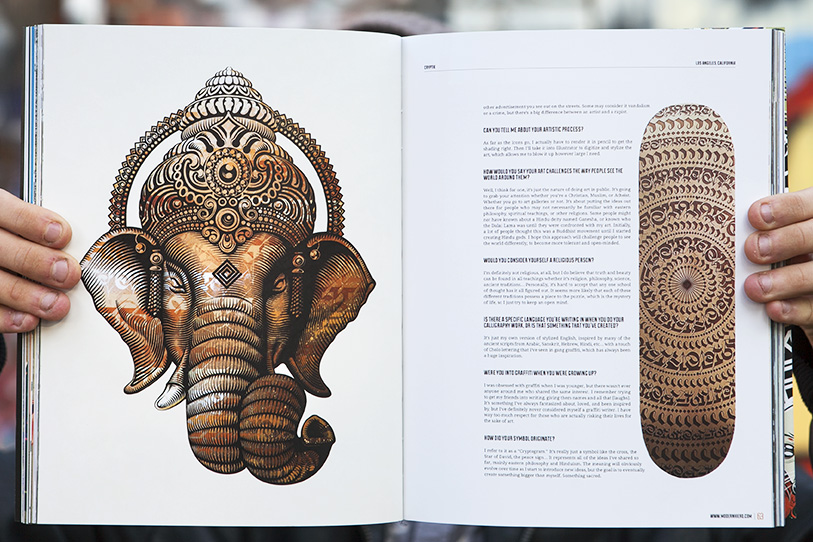
Do you think social media can perhaps help save print publications?
For sure. People say the Internet killed print, but I think they can coexist and even thrive together.
MH has a handful of launch parties for the new issue scheduled around the world over the next couple of weeks. Could you tell us more about these parties, where and how people can attend?
The 192-page second issue officially drops on January 30th at our release party at John Colins here in San Francisco. The following night, January 31st, we’ll be throwing a massive party in LA at Lot 613. The LA party will double as an afterparty for Flask Mob that night. Our friends from Soulection will be providing the music at both parties, shouts to Julio for helping us coordinate everything. Our main cover artist, Rik Oostenbroek, is flying out from Amsterdam and will be attending the SF and LA events to connect with the people there.
We leave for Hong Kong two days after LA, and we’ll be throwing a release party at CANVAS in Singapore on February 6th with a record label called Darker Than Wax. The party will open with a Q&A session with myself and one of our featured artists, Clogtwo, and we’ve booked musical acts from the UK, New Zealand, Singapore, and the US. It’s the ultimate intercontinental talent showcase.
After Singapore, we’ll be heading to Christchurch, New Zealand for Spectrum Street Art Festival, the largest street art fest in the Southern Hemisphere. Next is Melbourne, Australia, where we’ll be teaming with another print publication called T-world to throw an event titled “Print is Premium” on February 28th. At the event, we’ll be releasing our second issue and T-world will be releasing their eighth book, which they’ve been working on for seven years. I got my copy last week, and I’m not exaggerating when I tell you it’s the most beautiful publication I’ve ever seen. T-world has been a huge inspiration to me over the years and it’s really an honor to be working with them.
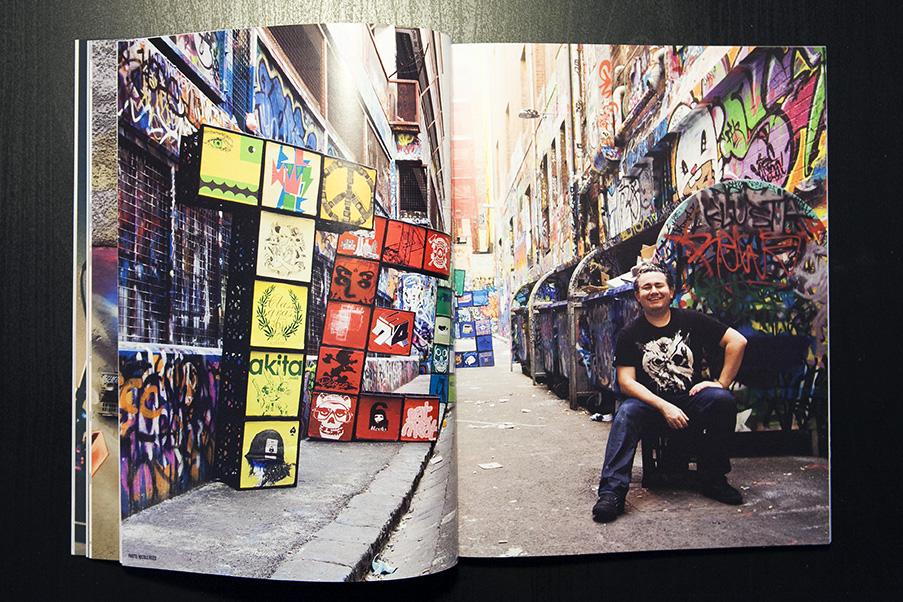
What’s up next for Modern Hieroglyphics?
Modern Hieroglyphics will be on the shelves of Barnes and Noble in a week, which is crazy to me, considering we just officially launched six months ago. We’ll be ramping up our blog and building a team of writers, and I’ve been working on a bunch of content to drop online over the next few months. From a creative standpoint, my vision for the magazine is constantly evolving. I try to keep my mind as open as possible, which makes every single day different. When it comes to the magazine and my own life, I want to allow myself the freedom to completely change my direction at any time, if I feel it’s right. It’s been a wild ride since I embarked on this journey a year ago and I have no intention of slowing down any time soon.
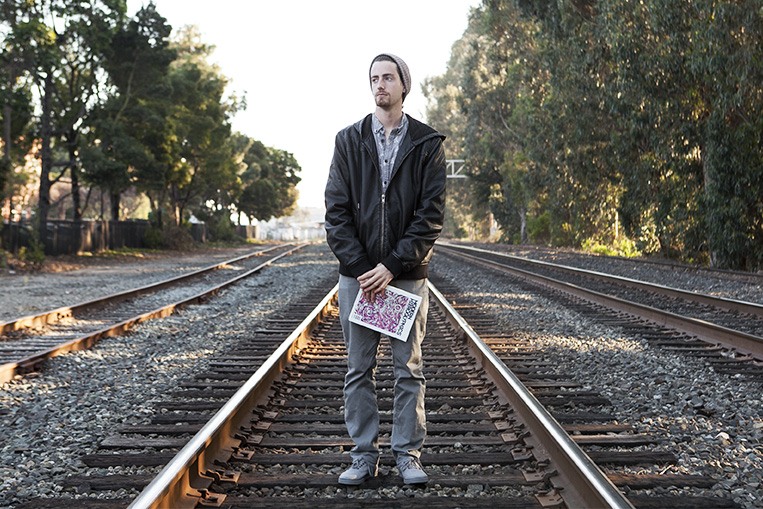
The second issue of Modern Hieroglyphics Magazine is available for purchase at www.modernhiero.com.
::
Facebook – https://facebook.com/modernhieroglyphics
Instagram – http://www.instagram.com/modernhiero (@modernhiero)
Upcoming Events:
San Francisco – http://bit.ly/sfmodernhiero
Los Angeles – http://bit.ly/lamodernhiero
Singapore – http://bit.ly/sgmodernhiero
Melbourne – TBA

